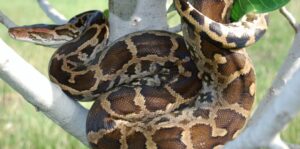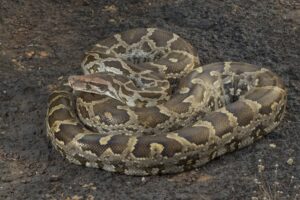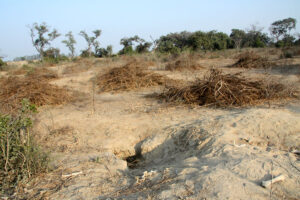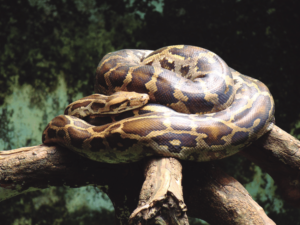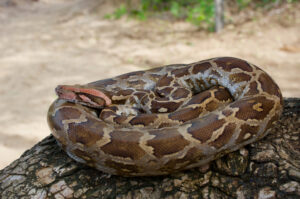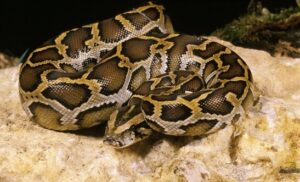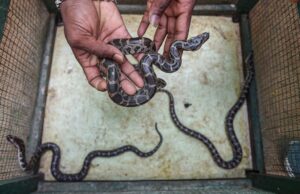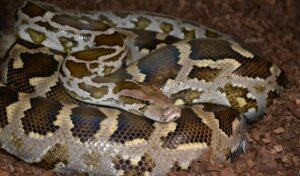The Indian python is one of the longest snakes in the world. They are commonly known as Asian, black-tailed, and Indian rock pythons. Despite being smaller than the Burmese python, this python is still one of the world’s largest snakes. This species was first described by famous Swedish zoologist Carl Linnaeus in 1758.
These are solitary creatures, only seeking out other members of their species during the mating season. Indian pythons are extremely lazy, timid, and slow-moving both in captivity as well as in the wild. Even when they are being attacked, they rarely make any move to defend themselves.
They show nocturnal behavior and are also excellent climbers, often seen hanging from tree branches. From October to February, these pythons go into hibernation.
In The Jungle Book by Rudyard Kipling, Kaa is a 30 ft long Indian python who is Mowgli’s mentor and a trusted ally aside from Bagheera and Baloo.
Scientific Classifications
- Suborder:Serpentes
- Family:Pythonidae
- Genus:Python
- Species:P. molurus
Conservation Status
Subspecies
The Indian python has one known subspecies:
- Python molurus pimbura
Description
Size
Indian pythons can reach up to 9-20 ft. (3-6 m) with an average weight of 70-129 lbs (31-58 kg).
Color and Appearance: It has a long, stocky body with colors ranging from whitish to yellow and is covered in dark brown to tan blotchy patterns.
Their color range varies depending on where they live. For example, the population in Assam and the Western Ghats’ hill forests tends to be darker than the specimens of the Eastern Ghats and Deccan Plateau, which mostly have a lighter shade.
They have triangular heads with small and granular scales, blunt snouts, and small eyes with vertical pupils. Many specimens have stripes from near their noses extending through the eyes to the back of their heads. However, the section in front of their eyes starts fading as they age, and only the stripes behind the eyes can be seen. Their scales are small, smooth, and shiny.
Are they Dangerous
Despite being non-venomous, they are capable of delivering a powerful bite. But they are mostly docile and are even kept as a pet by people. However, depending on each individual, their temperament can be both docile and aggressive.
Indian Python At a Glance
Distribution
The distribution of the Indian python ranges across Bangladesh, Bhutan, India, Pakistan, southern Nepal, Sri Lanka, and the north of Myanmar.
Habitat
These snakes prefer swamp areas where they can submerge fully. They also inhabit grasslands, open forests, marshes, river valleys, rocky foothills, swamps, and woodlands as long as they can access a permanent water source. Indian pythons are excellent swimmers, staying underwater for up to 30 minutes without breathing.
They can take shelter in burrows abandoned by other mammals, dense water reeds, hollow trees, and mangrove thickets.
Lifespan
The average lifespan of an Indian python is about 20-30 years.
Predators
Natural enemies of these snakes include crocodiles, eagles, hyenas, and large cats like leopards and tigers.
Diet
Their primary diet consists of small mammals like rodents, but they will also feed on amphibians, small birds, and reptiles.
Once these ambush predators locate a suitable meal, these snakes lunge towards it with their mouths open and tails quivering. After catching the prey with their mouths, they hold it with their reverse saw-like teeth, making it difficult for them to escape. Then they coil around its body, eventually killing it by suffocation and swallowing head first. They can unhinge their jaw so they can consume prey larger than themselves.
The Indian python generally hunts at night. This snake possesses heat-sensing pits in both jaws, which are very sensitive to temperature changes and helps them locate warm prey. They gather chemical samples in the atmosphere by flicking their tongue, which gets delivered to the Jacobson’s organ at the roof of their mouth.
They are known to fast for a prolonged time after consuming a heavy meal, with the longest fasting period recorded in an individual being two years. Like most pythons, these snakes do not move after finishing a heavy meal. Attempting to move following a meal, especially after consuming animals with horns and hooves, can rupture the snake’s stomach from the inside. Sometimes, to escape predators, they might eject their meal from their bodies to move more quickly.
Reproduction
The mating season lasts from December to February. Males wrap their bodies around females, repeatedly flicking their tongues across their bodies and heads. After aligning their cloacae, males massage and stimulate females using their vestigial legs. Then receptive females raise their tails so the males can insert one of their hemipenes into their cloacae. Copulation lasts from 5-30 minutes.
The female lays 15-100 white to yellowish shiny soft-shelled eggs. They coil around the eggs to incubate, only leaving for a quick bask in the sun. Through muscular contractions or ‘shivering’, females can raise the temperature of their bodies above room temperature.
After 58-90 days of incubation, 45-60 cm hatchlings emerge from the shell. These snakes are independent from birth and grow rapidly. At ten days old, the baby pythons shed for the first time. Sexual maturity is gained at the age of 2-3.
Similar Species
Burmese Python
The Indian python can sometimes be confused with the Burmese python (Python bivittatus). This species was once considered a subspecies of the Indian python but later was recognized as a separate species.
Burmese pythons are larger than the Indian pythons, but they lack the eye-like spots on their sides and light reddish-pink stripes on the side of their heads. Indian pythons also have a diamond-shaped spot on their heads which is absent in Burmese pythons and are generally lighter in coloration.
Reticulated Python
Although the two pythons can appear somewhat similar, reticulated pythons are generally longer than Indian pythons.
Care Sheet
Size of the Enclosure: Since this is a large snake, it needs a comparatively large enclosure. For snakes up to 3 years old, 4ft x 2ft x 2ft is enough. However, fully grown adults would need an 8ft x 4ft x 4ft. enclosure size.
Substrate: Aspen bedding or cypress mulch, bio-active soil-based substrates are suitable for keeping these snakes.
Humidity: Around 50% for both juveniles and adults.
Temperature: Around 80-90⁰F
Lighting: There is no need to provide these snakes with lights like UVB; however, they need about 12 hours of basking under the sun.
Feeding: Juveniles need to be fed an appropriate amount every week. For adults, the interval between feeding should be 10-14 days for large meals and weekly if the portion is smaller.
Source
critter.science.com, rahulalvares.com, t3.ftcdn.net, californiaherps.com, researchgate.net, inaturalist.ca, cdn.siasat.com, studbooks.eu

